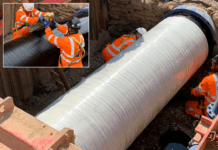With a nutrient neutral approach to new property developments expected to become more widespread across England, increasing numbers of developers are giving closer consideration to wastewater treatment, writes Andrew Baird, technical director at water recycling specialist WPL.

The concept of nutrient neutrality emerged in June 2019, when government advisor Natural England began issuing advice to local authorities with protected waters to only grant planning permission to new property developments proven to be nutrient neutral.
The guidance applies to areas with surface waters that are impacted by high levels of contaminants, primarily phosphate and nitrate. The contaminants, often referred to as nutrients, can lead to increased growth of algae, which can have a detrimental impact on water environments and ecosystems – a process known as eutrophication.
Nutrient neutrality is a means of ensuring new developments used for housing, mixed-use and tourism do not increase the nutrient burden of nearby protected waters.
For properties that are not on mains drainage, onsite wastewater treatment can be a significant part of the neutrality equation. WPL continues to see an increase in enquiries about its packaged wastewater treatment plants, which can remove up to 65% of nutrients found in wastewater. By comparison, the installation of a septic tank would have no positive impact on levels. WPL’s patented technology is fully compliant with Environment Agency regulations, which means final effluent can be safely discharged to a soakaway or watercourse.
The modular units can be installed in a tight footprint and once they are up-and-running, visual impact, energy consumption and maintenance requirements are low. WPL can provide documentation confirming the effectiveness of its equipment, which can be submitted with a planning application.
However, while onsite treatment is effective in removing a significant amount, developers must accept that there is no technology suitable for domestic use that would remove 100% of containments. Nutrient neutrality can only be achieved through a combination of measures and in most cases offsetting – removing nutrients elsewhere in the catchment – will have to be considered, which local planners can advise on.
With the environment at the heart of WPL’s operations, its research and development team, with support from Portsmouth University, is looking at further low-impact ways to remove more than 65% of nutrients. Our aim is to reduce levels for our utility, commercial and domestic customers, without the use of chemicals.
Technology being researched includes absorbent beads made from Zeolite, a naturally occurring mineral that will safely remove phosphorous. Elsewhere, we are trialling the use of ultraviolet light in treatment units to create a suitable environment for the growth of algae, which itself removes phosphorous, and can be retained in the sludge produced for removal by the waste carrier.
Developers should read Natural England’s guidance carefully, seek professional advice and of course contact WPL for clear technical advice.







